Optimum Design of Sunken Reinforced Enclosures under Buckling Condition
Abstract
1. Introduction
2. Model Description and Finite Element Analysis
Implementation Process of FE Simulation
3. Analytical Solution
4. Results and Discussion
4.1. Analytical Results
4.2. FE Results
5. Optimization Process of the Structure Weight
6. Conclusions
- Within the prevailing conditions, the best compartments were designed. The weight of the compartment was reduced by utilizing reinforced conductors while respecting the design principles and considering the minimum thickness.
- The stress results calculated using the analytical method are in good agreement with the results of finite element analysis.
- The final thicknesses computed against the load and local buckling had good and adequate strength. It seems that they can be used at arbitrary depths.
- The buckling shape mode is independent of material and can be used to classify the type of the buckling phenomenon.
- The finite element results reveal that the maximum stress occurs at the edge of the walls, so the most critical area in such structures is the edge of the outer wall or the corners.
Author Contributions
Funding
Conflicts of Interest
References
- Nouri, M.; Ashenai-Ghasemi, F.; Rahimi-Sherbaf, G.; Kashyzadeh, K.R. Experimental and Numerical Study of the Static Performance of a Hoop-Wrapped CNG Composite Cylinder Considering Its Variable Wall Thickness and Polymer Liner. Mech. Compos. Mater. 2020, 56, 339–352. [Google Scholar] [CrossRef]
- Walker, A.C. A brief review of plate buckling research. In The Behavior of Thin-Walled Structures; Elsevier: London, UK, 1984. [Google Scholar]
- Bijlaard, P.P.; Fisher, G.P. Interaction of Column and Local Buckling in Compression Members; NACA Technical Note 2640; National Advisory Committee for Aeronautics: Moffett Field, CA, USA, 1952.
- Bijlaard, P.P.; Fisher, G.P. Column Strength of H Sections and Square Tubes in the Postbuckling Range of the Component Plates; NACA Technical Note 2994; National Advisory Committee for Aeronautics: Moffett Field, CA, USA, 1953.
- Bresler, B. Design criteria for reinforced columns under axialload and biaxial bending. ACI J. Proc. 1960, 57, 481–490. [Google Scholar]
- Horowitz, B. Design of columns subjected to Biaxial bending. ACI Struct. J. 1989, 86, 717–722. [Google Scholar]
- Rafiq, M.Y. Genetic Algorithms in Optimum Design, Capacity Check and Final Detailing of Reinforced Concrete Columns. Trans. Built Environ. 1995, 13, 161–169. [Google Scholar]
- Cedolin, L.; Cusatis, G.; Eccheli, S.; Roveda, M. Biaxial bending of concrete columns: An analytical solution. Stud. Res. 2006, 26, 1–28. [Google Scholar]
- Yang, P.; Liu, H.; Huang, Z. A Comparison of seismic behavior between Specially Shaped Column frame structure and Rectangular Column frame structures. In Proceedings of the 14th World Conference on Earthquake Engineering, Beijing, China, 12–17 October 2008. [Google Scholar]
- Chen, Z.H.; Rong, B.; Fafitis, A. Axial compression stability of a crisscross section column Composed of concrete-filled square steel tubes. J. Mech. Mater. Struct. 2009, 4, 1787–1799. [Google Scholar] [CrossRef]
- Rodrigues, H.; Arêde, A.; Varum, H.; Costa, A.G. Experimental evaluation of rectangular reinforced concrete column behavior under biaxial cyclic loading. Earthq. Eng. Struct. Dyn. 2013, 42, 239–259. [Google Scholar] [CrossRef]
- Avcar, M. Elastic buckling of steel columns under axial compression. Am. J. Civ. Eng. 2014, 2, 102–108. [Google Scholar] [CrossRef]
- Gumble, A.N.; Pajgade, P.S. Comparison between specially shaped columns and rectangular columns in R.C. structure. Int. J. Adv. Eng. Res. Dev. 2015, 2, 679–684. [Google Scholar]
- Kervalishvili, A.; Talvik, L. Modified procedure for buckling of steel columns at elevated temperatures. J. Constr. Steel Res. 2016, 127, 108–119. [Google Scholar] [CrossRef]
- Dahiya, N.; Sehgal, V.K.; Saini, B. Analysis and Design of Rectangular and L-Shaped Columns Subjected to Axial Load and Biaxial Bending. Int. J. Struct. Eng. Anal. 2016, 2, 15–22. [Google Scholar]
- Mohammad, F.A.; Seyan, D.A. Optimum Design of Reinforced Concrete Rectangular Columns Subjected to Axial Compression and Biaxial Bending Moments. Athens J. Technol. Eng. 2016, 3, 225–239. [Google Scholar] [CrossRef]
- Munhoz, F.S.; Giongo, J.S. Variation analysis effects of square and rectangular columns section with different longitudinal reinforcement rates in the main reinforcement two pile caps analysis. IBRACON Struct. Mater. J. 2017, 10, 760–787. [Google Scholar] [CrossRef][Green Version]
- Jiang, J.; Zhang, J.; Liu, J.; Chiew, S.; Lee, C. Effect of welding and heat treatment on strength of high-strength steel columns. J. Constr. Steel Res. 2018, 151, 238–252. [Google Scholar] [CrossRef]
- Kandpal, U. Comparative Analysis of Rectangular and Square Column for Axial loading, Uniaxial & Biaxial Bending. Int. Res. J. Eng. Technol. 2018, 5, 465–468. [Google Scholar]
- Rasmussen, K.J.R.; Hancock, G.J. Tests of high strength steel columns. J. Constr. Steel Res. 1995, 34, 27–52. [Google Scholar] [CrossRef]
- Schuman, L.; Back, G. Strength of Rectangular Flat Plates under Edge Compression; NACA Report No.356; National Advisory Committee for Aeronautics: Moffett Field, CA, USA, 1930.
- Karman, T.; Sechler, E.E.; Donnel, L.H. The strength of thin plates in compression. Trans. ASME 1932, 54, 53–57. [Google Scholar]
- Patil, S.R.; Murthy, H.N.; Srivatsa, G.S.; Yandigeri, V.S.; Meti, B.; Angadi, G.; Harish, D.V.N. Study of Vibration Behaviour of Stiffened Polymer Composite Shells for Underwater Structural Applications. Def. Sci. J. 2020, 70, 342–350. [Google Scholar] [CrossRef]
- Chu, Y.L.; Wang, C.M.; Park, J.C.; Lader, P.F. Review of cage and containment tank designs for offshore fish farming. Aquaculture 2020, 519, 734928. [Google Scholar] [CrossRef]
- Strand, I.M.; Faltinsen, O.M. Linear wave-induced dynamic structural stress analysis of a 2D semi-flexible closed fish cage. J. Fluids Struct. 2020, 94, 102909. [Google Scholar] [CrossRef]
- Graves Smith, T.R. The ultimate strength of locally buckled columns of arbitrary length. In The Thin-Walled Steel Constructions; Crosby-Lockwood: London, UK, 1967. [Google Scholar]
- Bringas, J.E. Handbook of Comparative World Steel Standards, 3rd ed.; ASTM International: West Conshohocken, PA, USA, 2004. [Google Scholar]
- Koloor, S.S.R.; Abdullah, M.A.; Tamin, M.N.; Ayatollahi, M.R. Fatigue damage of cohesive interfaces in fiber-reinforced polymer composite laminates. Compos. Sci. Technol. 2019, 183, 107779. [Google Scholar] [CrossRef]
- Karimzadeh, A.; Koloor, S.S.R.; Ayatollahi, M.R.; Bushroa, A.R.; Yahya, M.Y. Assessment of nano-indentation method in mechanical characterization of heterogeneous nanocomposite materials using experimental and computational approaches. Sci. Rep. 2019, 9, 15763. [Google Scholar] [CrossRef] [PubMed]
- Mohamady, S.; Montazeri, A.; Ahmad, R.R. Modeling of sound-structure interaction in a rectangular enclosure using finite element method. IEEE Symp. Ind. Electron. Appl. 2009, 2, 748–753. [Google Scholar]
- Reza Kashyzadeh, K.; Farrahi, G.H.; Shariyat, M.; Ahmadian, M.T. Experimental and finite element studies on free vibration of automotive steering knuckle. Int. J. Eng. Trans. B Appl. 2017, 30, 1776–1783. [Google Scholar]
- Reza kashyzadeh, K. Effects of axial and multiaxial variable amplitude loading conditions on the fatigue life assessment of automotive steering knuckle. J. Fail. Anal. Prev. 2020, 20, 455–463. [Google Scholar] [CrossRef]
- Reza Kashyzadeh, K. A new algorithm for fatigue life assessment of automotive safety components based on the probabilistic approach: The case of the steering knuckle. Eng. Sci. Technol. Int. J. 2020, 32, 392–404. [Google Scholar] [CrossRef]
- Flugge, W. Stresses in Shells; Julius Springer: Berlin, Germany, 1960. [Google Scholar]
- Timoshenko, S.; Woinowsky-Krieger, S. Theory of Plates and Shells; McGraw–Hill Publishing Co., Inc.: New York, NY, USA, 1960. [Google Scholar]
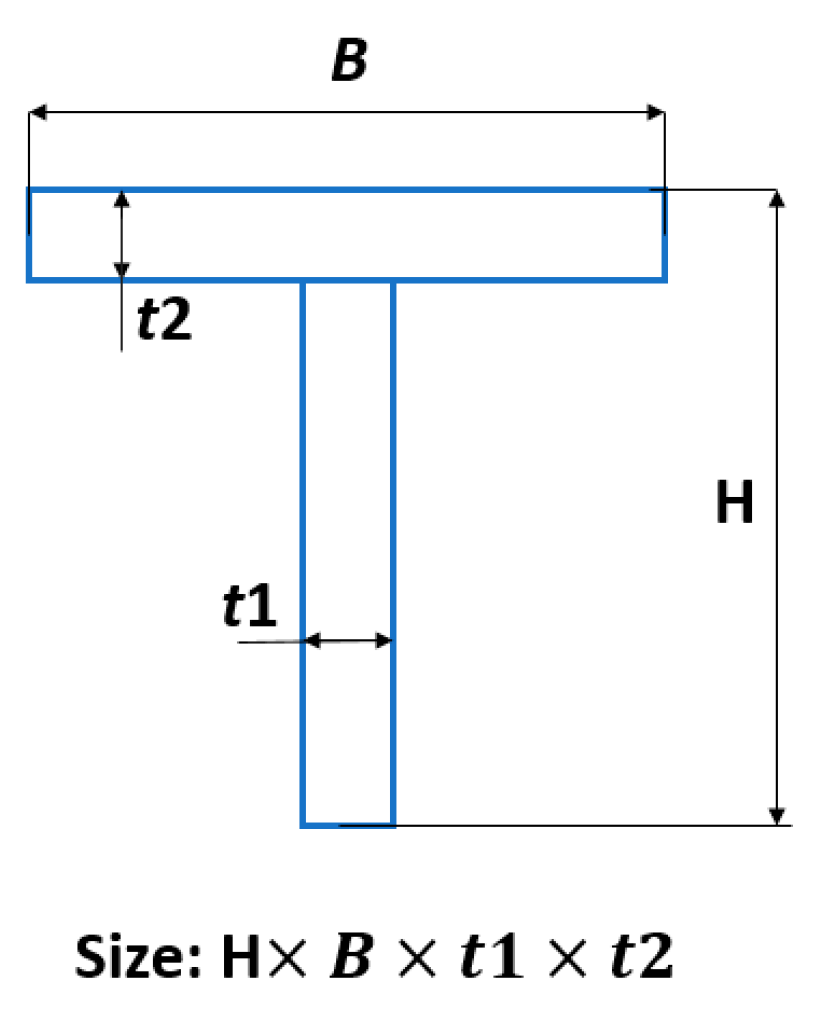
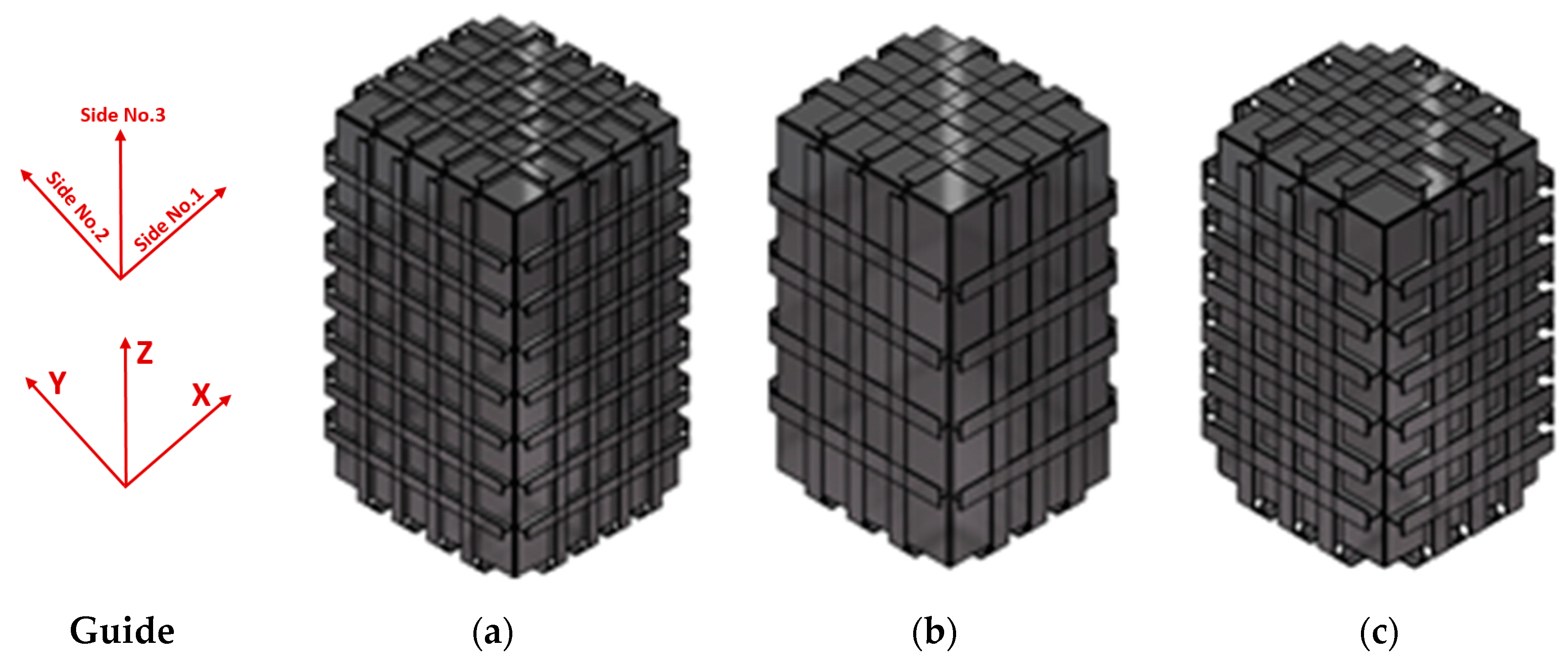
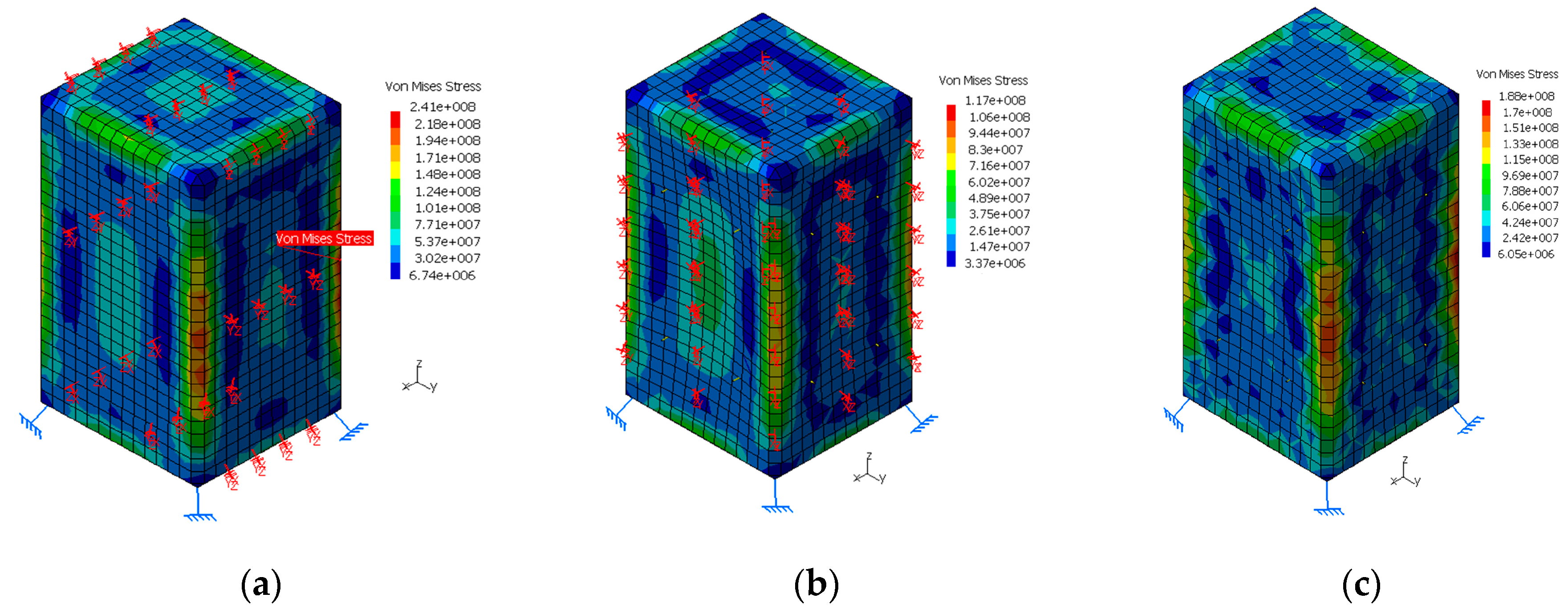
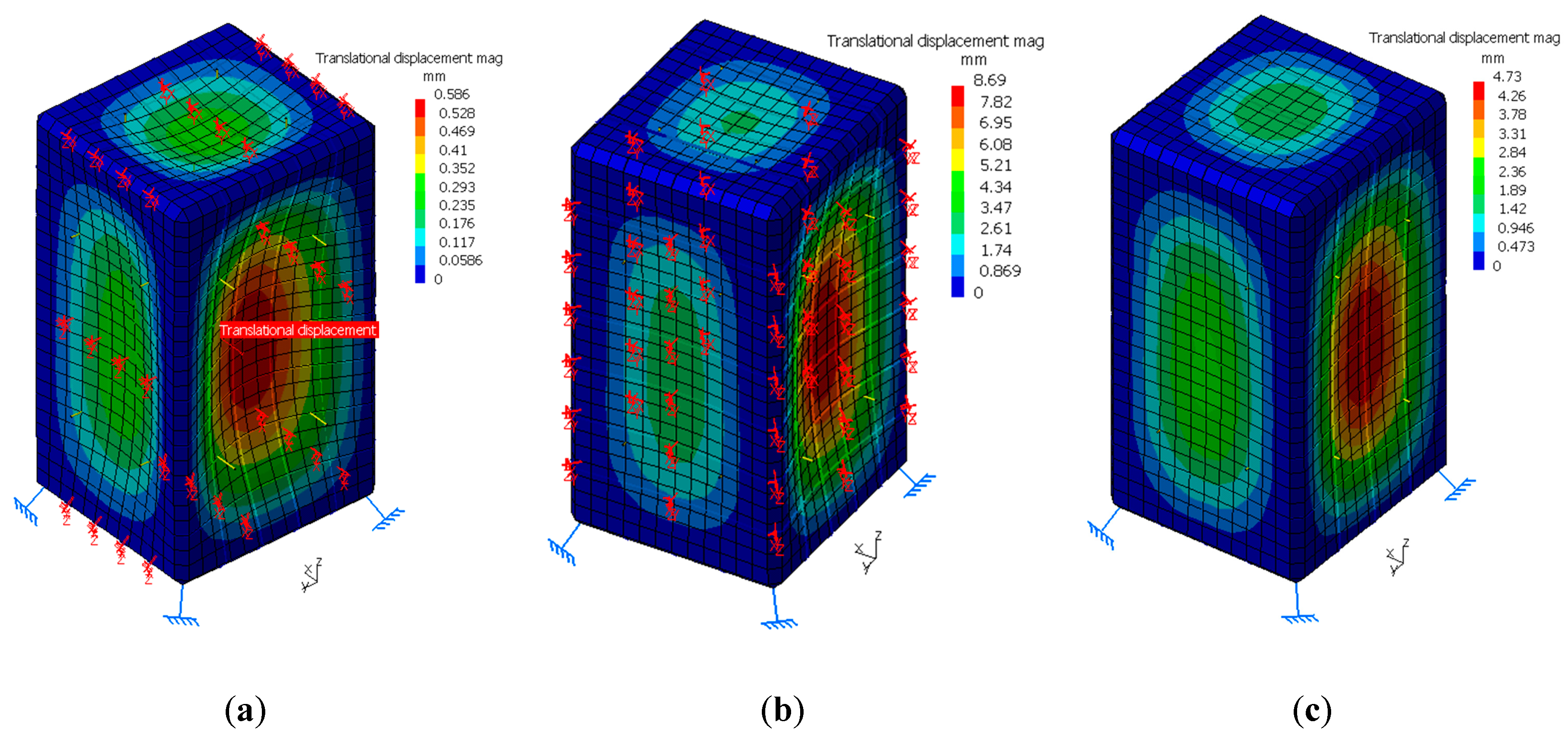

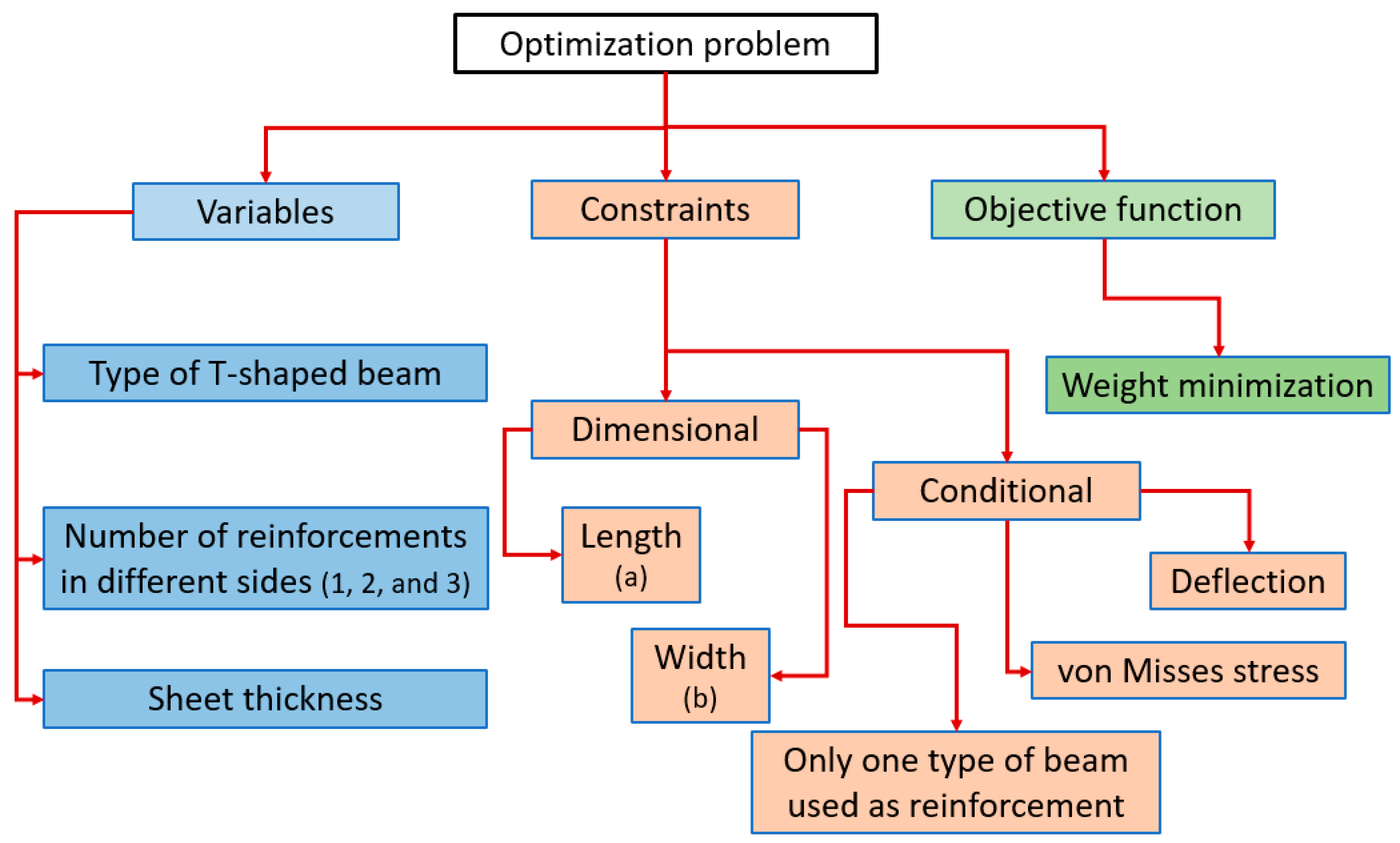
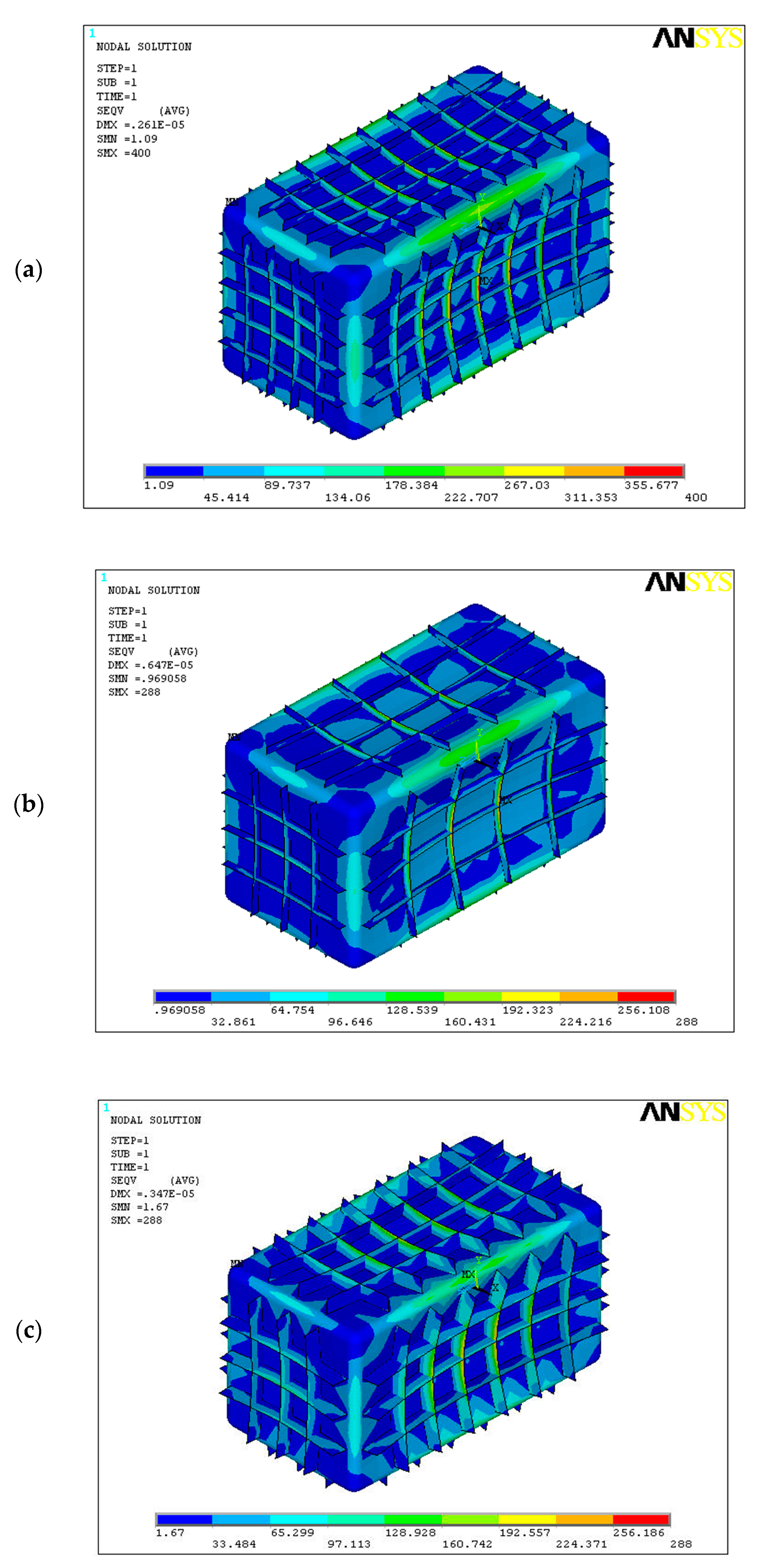
| Material | Number of T-Shaped Beams | Cross-Section Dimensions (mm) | Side of Reinforcements |
|---|---|---|---|
| Steel | 4 | 50 × 50 × 5 × 5 | 1 |
| 4 | 50 × 50 × 5 × 5 | 2 | |
| 7 | 50 × 50 × 5 × 5 | 3 | |
| Aluminum (depth of 20 m) | 3 | 80 × 80 × 9 × 9 | 1 |
| 3 | 80 × 80 × 9 × 9 | 2 | |
| 4 | 80 × 80 × 9 × 9 | 3 | |
| Aluminum (depth of 60 m) | 3 | 80 × 80 × 9 × 9 | 1 |
| 3 | 80 × 80 × 9 × 9 | 2 | |
| 6 | 80 × 80 × 9 × 9 | 3 |
| External Dimensions (mm) Length × Width × Height | Internal Dimensions (mm) Length × Width × Height | Poisson Ratio | Young’s Modulus (GPa) | (MPa) | Safety Factor | Depth (m) | Body Material |
|---|---|---|---|---|---|---|---|
| 828 × 898 × 1551 | 768 × 838 × 1493 | 0.266 | 210 | 400 | 2.7 | 60 | St60 |
| 0.346 | 72.7 | 288 | 4 | 20 | Al5083H321 | ||
| 0.346 | 72.7 | 288 | 4 | 60 | Al5083H321 |
| Materials | Geometric Parameters of the Sheet | Stress Components | Von Misses Stress | W(x, y) | ||||
|---|---|---|---|---|---|---|---|---|
| a | b | t | ||||||
| Steel | 798 | 1522 | 36 | 170.52 | 76.16 | 0 | 148.15 | 2.3 |
| 868 | 1522 | 37.8 | 171.47 | 83.98 | 0 | 148.37 | 3 | |
| 798 | 868 | 27.7 | 156.39 | 139.45 | 0 | 148.57 | 1.1 | |
| Aluminum (depth of 20 m) | 798 | 1522 | 30 | 82.89 | 42.78 | 0 | 71.78 | 3.5 |
| 868 | 1522 | 31.7 | 82.99 | 46.07 | 0 | 72.05 | 4.6 | |
| 798 | 868 | 23.7 | 74.95 | 68.36 | 0 | 71.93 | 1.7 | |
| Aluminum (depth of 60 m) | 798 | 1522 | 51.9 | 83.16 | 42.69 | 0 | 72.02 | 2 |
| 868 | 1522 | 54.9 | 82.95 | 46.12 | 0 | 72.00 | 2.7 | |
| 798 | 868 | 41 | 74.96 | 68.41 | 0 | 71.98 | 1 | |
| Material | Critical Value of N | n | m | a | b | t | No. Sheet |
|---|---|---|---|---|---|---|---|
| Steel | 3.01 × 107 | 1 | 1 | 798 | 868 | 38 | 1 |
| 7.16 × 107 | 2 | 1 | 798 | 868 | 38 | 2 | |
| 1.8 × 107 | 1 | 1 | 868 | 1522 | 38 | 3 | |
| 3.2 × 107 | 2 | 1 | 868 | 1522 | 38 | 4 | |
| 2 × 107 | 1 | 1 | 798 | 1522 | 38 | 5 | |
| 3.4 × 107 | 2 | 1 | 798 | 1522 | 38 | 6 | |
| Aluminum (depth of 20 m) | 6.5 × 106 | 1 | 1 | 798 | 868 | 32 | 1 |
| 1.5 × 107 | 2 | 1 | 798 | 868 | 32 | 2 | |
| 3.9 × 106 | 1 | 1 | 868 | 1522 | 32 | 3 | |
| 6.8 × 106 | 2 | 1 | 868 | 1522 | 32 | 4 | |
| 4.5 × 106 | 1 | 1 | 798 | 1522 | 32 | 5 | |
| 7.3 × 106 | 2 | 1 | 798 | 1522 | 32 | 6 | |
| Aluminum (depth of 60 m) | 3.2 × 107 | 1 | 1 | 798 | 868 | 55 | 1 |
| 7.7 × 107 | 2 | 1 | 798 | 868 | 55 | 2 | |
| 1.9 × 107 | 1 | 1 | 868 | 1522 | 55 | 3 | |
| 3.4 × 107 | 2 | 1 | 868 | 1522 | 55 | 4 | |
| 3.2 × 107 | 1 | 1 | 798 | 1522 | 55 | 5 | |
| 3.7 × 107 | 2 | 1 | 798 | 1522 | 55 | 6 |
| Compartment Type | Maximum Deformation (mm) | Critical Stress (Mpa) | Safety Factor |
|---|---|---|---|
| St 60 | 0.586 | 241 | 3 |
| Al + depth 20 | 8.69 | 117 | 2.4 |
| Al + depth 60 | 4.73 | 188 | 2 |
| Mode No. | BF | ||
|---|---|---|---|
| Steel | Al + Depth 20 | Al + Depth 60 | |
| 1 | 179.99 | 12.259 | 23.474 |
| Compartment Type | Type of Reinforced Beam | Number of Beams | Sheet Thickness (mm) | Safety Factor | Weight (kg) |
|---|---|---|---|---|---|
| Steel | 50 T | 4, 4, 7 | 10 | 3 | 1199 |
| Al + Depth 20 | 40 × 80 × 7 T | 3, 3, 4 | 12 | 2.83 | 305 |
| Al + Depth 60 | 80 × 80 × 9 T | 3, 3, 6 | 8 | 3.51 | 446 |
Publisher’s Note: MDPI stays neutral with regard to jurisdictional claims in published maps and institutional affiliations. |
© 2020 by the authors. Licensee MDPI, Basel, Switzerland. This article is an open access article distributed under the terms and conditions of the Creative Commons Attribution (CC BY) license (http://creativecommons.org/licenses/by/4.0/).
Share and Cite
Omidi Bidgoli, M.; Kashyzadeh, K.R.; Rahimian Koloor, S.S.; Petrů, M.; Amiri, N. Optimum Design of Sunken Reinforced Enclosures under Buckling Condition. Appl. Sci. 2020, 10, 8449. https://doi.org/10.3390/app10238449
Omidi Bidgoli M, Kashyzadeh KR, Rahimian Koloor SS, Petrů M, Amiri N. Optimum Design of Sunken Reinforced Enclosures under Buckling Condition. Applied Sciences. 2020; 10(23):8449. https://doi.org/10.3390/app10238449
Chicago/Turabian StyleOmidi Bidgoli, Mostafa, Kazem Reza Kashyzadeh, Seyed Saeid Rahimian Koloor, Michal Petrů, and Nima Amiri. 2020. "Optimum Design of Sunken Reinforced Enclosures under Buckling Condition" Applied Sciences 10, no. 23: 8449. https://doi.org/10.3390/app10238449
APA StyleOmidi Bidgoli, M., Kashyzadeh, K. R., Rahimian Koloor, S. S., Petrů, M., & Amiri, N. (2020). Optimum Design of Sunken Reinforced Enclosures under Buckling Condition. Applied Sciences, 10(23), 8449. https://doi.org/10.3390/app10238449








